Halloween III: Season of the Witch Blu-ray Movie
HomeHalloween III: Season of the Witch Blu-ray Movie 
4K ScanShout Factory | 1982 | 98 min | Rated R | Oct 16, 2018
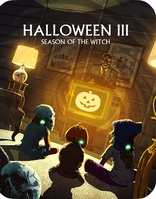
Movie rating
6.6 | / 10 |
Blu-ray rating
| Users | 4.0 | |
| Reviewer | 3.5 | |
| Overall | 3.5 |
Overview
Halloween III: Season of the Witch (1982)
After the mysterious death of a toyshop owner, a doctor and the man's daughter investigate the Irish-dominated Northern California community of Santa Mira, a company town owned by the Silver Shamrock Novelty corporation.
Starring: Tom Atkins, Stacey Nelkin, Dan O'Herlihy, Michael Currie, Ralph StraitDirector: Tommy Lee Wallace
| Horror | Uncertain |
| Thriller | Uncertain |
| Supernatural | Uncertain |
Specifications
Video
Video codec: MPEG-4 AVC
Video resolution: 1080p
Aspect ratio: 2.35:1
Original aspect ratio: 2.39:1
Audio
English: DTS-HD Master Audio 2.0 Mono (48kHz, 24-bit)
Subtitles
English SDH
Discs
Blu-ray Disc
Single disc (1 BD)
Playback
Region A (locked)
Review
Rating summary
| Movie | 3.5 | |
| Video | 3.5 | |
| Audio | 3.0 | |
| Extras | 3.5 | |
| Overall | 3.5 |
Halloween III: Season of the Witch Blu-ray Movie Review
Reviewed by Dr. Stephen Larson October 29, 2018After Halloween II, John Carpenter and Debra Hill thought they had taken the Michael Myers storyline as far it could go so they set about producing a different Halloween story each year. Carpenter and Hill came up with the concept of "witchcraft meets the computer age" that featured in a 1982 publicity booklet that Universal Studios printed. My research indicates that Carpenter and Hill first wrote a short treatment for Halloween III and enlisted British writer Nigel Kneale (the Quatermass trilogy) to write a screenplay. Carpenter regarded Kneale's script a little too far-out and esoteric so he did a rewrite himself. Carpenter's chum and close collaborator Tommy Lee Wallace was chosen to direct. There were aspects in Carpenter's script that Wallace felt needed revisions so he did his own rewrite. According to Wallace, 60 percent of Kneale's first draft is kept in the final shooting script. However, Kneale was reportedly disenchanted with Wallace's changes and asked that his name be removed from the final credits.
The roman numeral III was added on to Halloween not only because it was the second sequel in the series but also, as Wallace divulged to Fangoria, to signify the three latex rubber masks created by Don Post: a glow-in-the-dark skull, a bright day-glo orange pumpkin head, and a luminescent green witch face to go with a black hood. These Silver Shamrock novelties were mass produced and used as merchandising tie-ins when the movie opened in late October 1982. Wallace, cinematographer Dean Cundey, and other cast/crew members lament that the film had to have Halloween III in the title and believe it would have performed much better if it had just been called Season of the Witch or some other title. In fact, Wallace stated that Universal insisted that it be labeled a sequel or it would not have been made. While I share the sentiment by Wallace, Cundey, et al., I believe that if Carpenter directed it, then the studio would have let him put his name above Season of the Witch and drop the direct Halloween connection. By 1982, Carpenter had developed respect, autonomy, and sufficient clout within the industry to allow him to make such decisions.
I've always been very curious why Halloween III was supposedly a critical misfire and box-office dud. Some of my findings may surprise readers. The film was not universally disliked by critics but met with a much more mixed reception. Sure, several were poor but I haven't found any critic who listed Season of the Witch among the worst films of 1982. A number of reviewers appreciated the alternate detours it took away from the first two installments. For instance, the Philadelphia Daily News' critic Joe Batalke found it refreshing that Part III "not only openly disassociates itself from the two previous Halloween movies, but also comes up with a crafty, insinuatingly evil plotline that's shrewdly resourceful." Jeff Short of Palladium-Item (Richmond, IN) praised Halloween III for being a "cut above slasher flicks....it's original and, at times, it's entertaining....at long last, it's broken the chain of mindless
slasher films spawned by its grandfather in 1978." Moreover, Bill Kelley, an entertainment writer for the South Florida Sun Sentinel headlined his review with "Latest 'Halloween' sequel much better than expected." He considers it a "cleverly written and exceptionally well directed science fiction/horror thriller." Kelley also credits Wallace with infusing the film with a black humor that gives it a "welcome diversion." In sum, he regards it a "step up from low-grade sexism and gore of the second entry in the cycle."
According to Variety, the third film opened on nearly 1,300 screens and did respectable business during its first two weeks in wide release. By mid-November, however, attendance dropped and so did the number of screens (192). This is not to say that audience reaction was all negative. Dan Craft, the longtime critic for The Pantagraph (Central, IL) watched Halloween III with a matinee audience (probably college aged) who I believe had an appreciation for the magic and ingeniousness ofr special makeup f/x in early eighties horror. For the scene where the gray-suit assassin (Dick Warlock) rips off the head of a poor bum, Craft heard a viewer react: "Oh, excellent, excellent, that was really excellent!" By contrast, Stephen Hunter of The Baltimore Sun sat with a far different audience that "howled in disgust" not at that scene but at the shot where Challis throws his mask at the surveillance camera in his cell. Apparently, they thought it didn't pass the realism test.
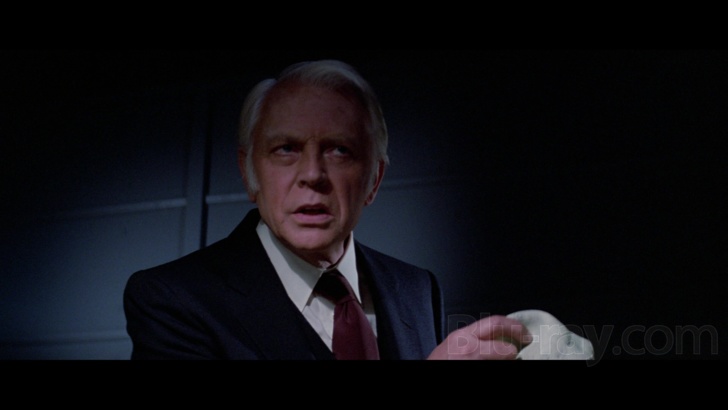
You must obey and submit to me!
My theory for Season of the Witch's dwindling returns has to do with an ill-conceived ad and marketing campaign as much as it has to do with bad word-of-mouth. In one of the newspaper clippings included in the still gallery on this Shout! Factory disc, The Shape's face is superimposed above a Halloween III ad along with a photo of Jamie Lee Curtis and Tom Atkins from The Fog! This speciously gave a very misleading impression that both Michael and Laurie would be returning for another film. This also gave fans of the first two films prepackaged expectations that they would be seeing a continuation of the knife man and final girl plot. Additionally, Universal's publicity materials (adverts, TV spots, trailers, etc.) all carried the tagline, "The night no one comes home," which was a variant of the first film's "The night he came home." Universal failed to give the moviegoing public a precise inkling of what III would be about and who would be in it.
While I'm fond of Season of the Witch, I have the same problem with how Dr. Daniel Challis is written as I do with Tom Atkins's character (named Nick Castle, after Carpenter's film school buddy) in The Fog. Atkins was too old (by twenty-three years) for Curtis's Elizabeth Solley and the romance feels rather swift and forced. Stacey Nelkin is nearly a year younger than Curtis and when Atkins make loves to her in the motel room, it seems unrealistic and out of place. I understand why Wallace would have Challis give paternal affection and comfort to Nelkin's Ellie Grimbridge after her father's shocking demise. Another reason is Challis's magpie ex-wife, Linda (Nancy Loomis), who is so upset over her former spouse's excuses for not being able to see their kids that she stops listening to him altogether. In addition, I took issues with narrative choices that Wallace made in the third act and climax.
What redeems the film in the second half is the alternately classy and chilly performance by the venerable Dan O'Herlihy as Conal Cochran, an evil and autocratic toymaker. Cochran exerts Orwellian control over the town of Santa Mira, California (where Invasion of the Body Snatchers is also set) and the automatons in his factory. Cochran is an apposite antagonist by Kneale since he previously wrote the teleplay to the BBC adaptation of Nineteen Eighty-Four back in 1954 and could relate similar personality traits to Orwell's character, O'Brien. Wallace was criticized for not building up enough suspense but he heightens the fright and fear all throughout the factory. Season of the Witch is a grim technological parable about inducing and hypnotizing humankind (predominately children) into accepting consumerist messages that look appealing on screen but are really lethal.
Halloween III: Season of the Witch Blu-ray Movie, Video Quality 
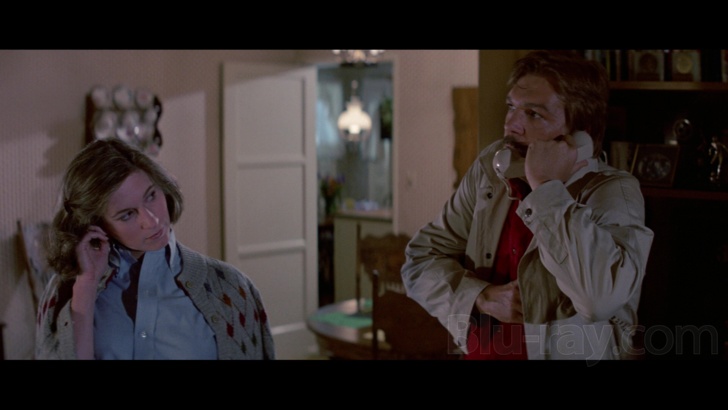
Shout! has re-released Halloween III: Season of the Witch in a Limited SteelBook edition (first run: 10,000 copies) on this MPEG-4 AVC-encoded BD-50. Wallace's feature debut appears in original Panavision anamorphic (2.35:1), maintaining the same screen ratio as the theatrical exhibition. This 4K scan is advertised as again struck from one of the negatives. Although Dean Cundey's name is not listed on the packaging specs, he recently told journalist David Muñoz that he and Carpenter went over the releases for the reissued Halloween films and "redoing them for an extremely clean and sharpest image you can get." Shout! has boosted the transfer's average bitrate from 29449 kbps on the 30th Anniversary "Silver Shamrock" Edition to 35000 kbps on this newly pressed disc. Some noise reduction tools have been applied. The image here has less artifacts. I only spotted tiny white nicks in shots across three or four scenes. The 2012 transfer looks a notch brighter. I've arranged a comparison between the two in Screenshot #s 10-20 with the oldest on top. The 2018 image has more of a desaturated appearance. I noticed a tinge more white inside the hallways of Challis's clinic and when the doc calls his ex from a phone booth (#14). Overall, colors are more muted on the new transfer. The BD-50 sports a total bitrate of 42.71 Mbps (up from 36.73 Mbps on the Blu-ray six years ago).
Screenshots 1-10, 12, 14, 16, 18, & 20 = Shout! Factory 2018 4K Scan
Screenshots 11, 13, 15, 17, & 19 = Shout! Factory 2012 Transfer
The 98-minute feature has been given eighteen scene selections.
Halloween III: Season of the Witch Blu-ray Movie, Audio Quality 
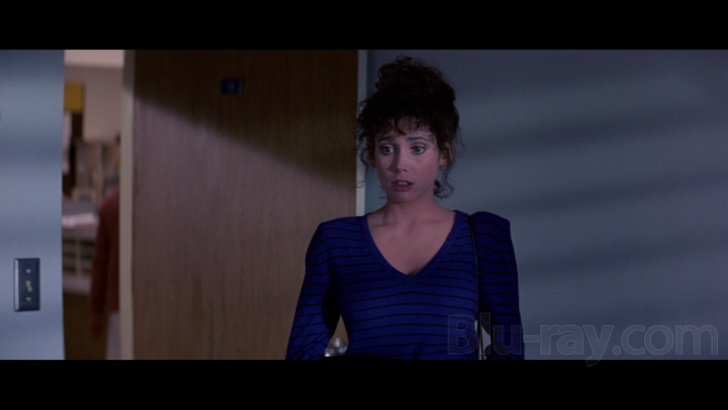
Shout! Factory has supplied the original DTS-HD Master Audio 2.0 Dual Mono (2000 kbps, 24-bit). This is also technically superior to to the 2012 uncompressed track, which averages 1685 kbps. Spoken dialogue—whether American, Irish, or British accents—should be clear and discernible to the lay viewer. In another joint collaboration, Carpenter and Alan Howarth crafted a propulsive score full of original compositions that were new to the series. The pair satirized Vangelis's Oscar-winning Chariots of Fire with "Chariots of Pumpkins", a jaunty electronic romp that plays post-credits while Harry Grimbridge (Al Berry) tries to get away from the men in gray flannel suits. Carpenter and Howarth also produce some smashing bass and synth beats in "First Chase", perfectly capturing the plight of a man in heavy pursuit. Music sounds punchy, clean, and distinct. This is a front-heavy mix. My audio score is 3.25.
Brand new to this edition is an optional English SDH. I watched the film with the track on and it's free of typographical errors.
Halloween III: Season of the Witch Blu-ray Movie, Special Features and Extras 
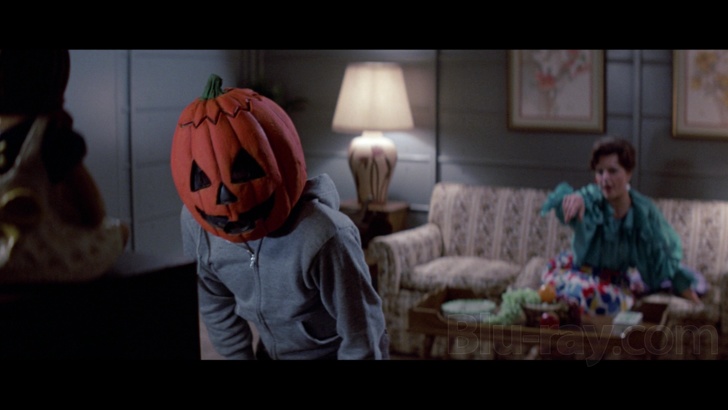
Shout! has ported over all of its bonus materials from '12. For a detailed description of each, please see Marty Liebman's review.
- Audio Commentary with Writer/Director Tommy Lee Wallace
- Audio Commentary with Actor Tom Atkins
- Stand Alone: The Making of HALLOWEEN III: SEASON OF THE WITCH (33:10, 1080p) - Featuring Interviews with Writer/Director Tommy Lee Wallace, Actors Tom Atkins, Stacey Nelkin, Brad Schacter, Stunt Coordinator Dick Warlock, Executive Producer Irwin Yablans, Director of Photography Dean Cundey, and Co-Composer Alan Howarth.
- Horror's Hallowed Grounds: The Locations of Halloween III (19:45, 1080p) - Host Sean Clark and Writer/Director Tommy Lee Wallace Revisit the Original Shooting Locations of the Film
- Teaser Trailer and Theatrical Trailer (2:45, 1080p)
- Radio Spots (1:43)
- TV Spots (1:35, 480p)
- Still Gallery (6:19, 1080p)
- Posters & Lobby Cards Gallery (3:00, 1080p)
Halloween III: Season of the Witch Blu-ray Movie, Overall Score and Recommendation 
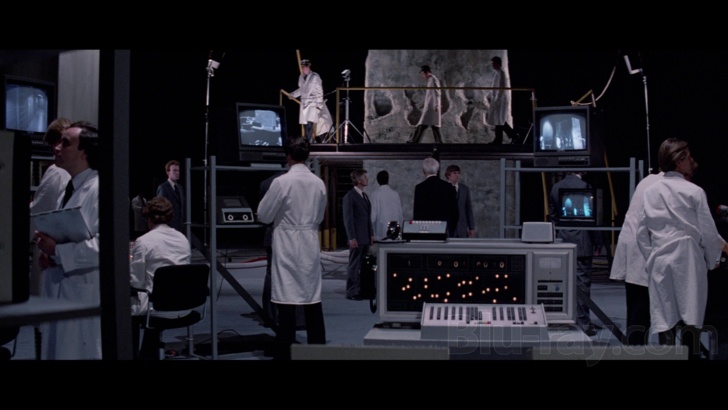
Halloween III: Season of the Witch was largely misunderstood upon its original cinema release but has rightfully gained a second following in the years since. Wallace's picture would make a terrific double feature with Michael Radford's 1984 (released two years later). H3 is very good but Dennis Etchison (again using the alias Jack Martin) wrote a novelization based on one of Wallace's screenplays that's even better. It contains scenes that were probably never filmed and fleshes out the characters more. It also fills in plot holes and covers for narrative logic and plausibility that the film lacks. Paperback copies are becoming scarcer so get them while they're still around. There are some notable differences in lighting, density, and softness between the 2012 and 2018 transfers of the film so I would go with whichever you're more partial to. RECOMMENDED to all Halloween fans.
Other editions
Halloween III: Season of the Witch: Other Editions

Halloween III: Season of the Witch
Collector's Edition
1982

Halloween III: Season of the Witch
The Complete Collection Edition
1982

Halloween III: Season of the Witch
1982

Halloween III: Season of the Witch 4K
Collector's Edition
1982

Halloween III: Season of the Witch 4K
Collector's Edition | Exclusive Red, Yellow and Orange Splatter 7" Vinyl + Poster
1982

Halloween III: Season of the Witch 4K
Collector's Edition | Sacred Bones Exclusive | Exclusive Black, White and Orange Splatter 7" Vinyl
1982

Halloween III: Season of the Witch 4K
Collector's Edition
1982
Similar titles
Similar titles you might also like

Halloween 5: The Revenge of Michael Myers 4K
Collector's Edition
1989

Halloween 4: The Return of Michael Myers 4K
Collector's Edition
1988

Halloween: The Curse of Michael Myers
Unrated Producer's Cut | Halloween 6
1995

Halloween: Resurrection
Halloween 8
2002

Halloween II 4K
Collector's Edition
1981

Halloween H20: Twenty Years Later 4K
Limited Edition
1998

Halloween II
Unrated Director's Cut
2009

Halloween
Unrated Collector's Edition
2007

Halloween 4K
Collector's Edition
1978

Child's Play 4K
1988

Friday the 13th Part 2
1981

Child's Play
2019

Friday the 13th 4K
1980

Friday the 13th: Part VII - The New Blood
Friday The 13th Collection Deluxe Edition Version
1988

Friday the 13th: Part 3
1982

Jason Goes to Hell: The Final Friday 4K
Limited Edition
1993

Jason X 4K
Limited Edition
2001

Freddy vs. Jason
2003

A Nightmare on Elm Street 4K
1984

Silent Night, Deadly Night 4K
40th Anniversary Edition | Collector's Edition
1984